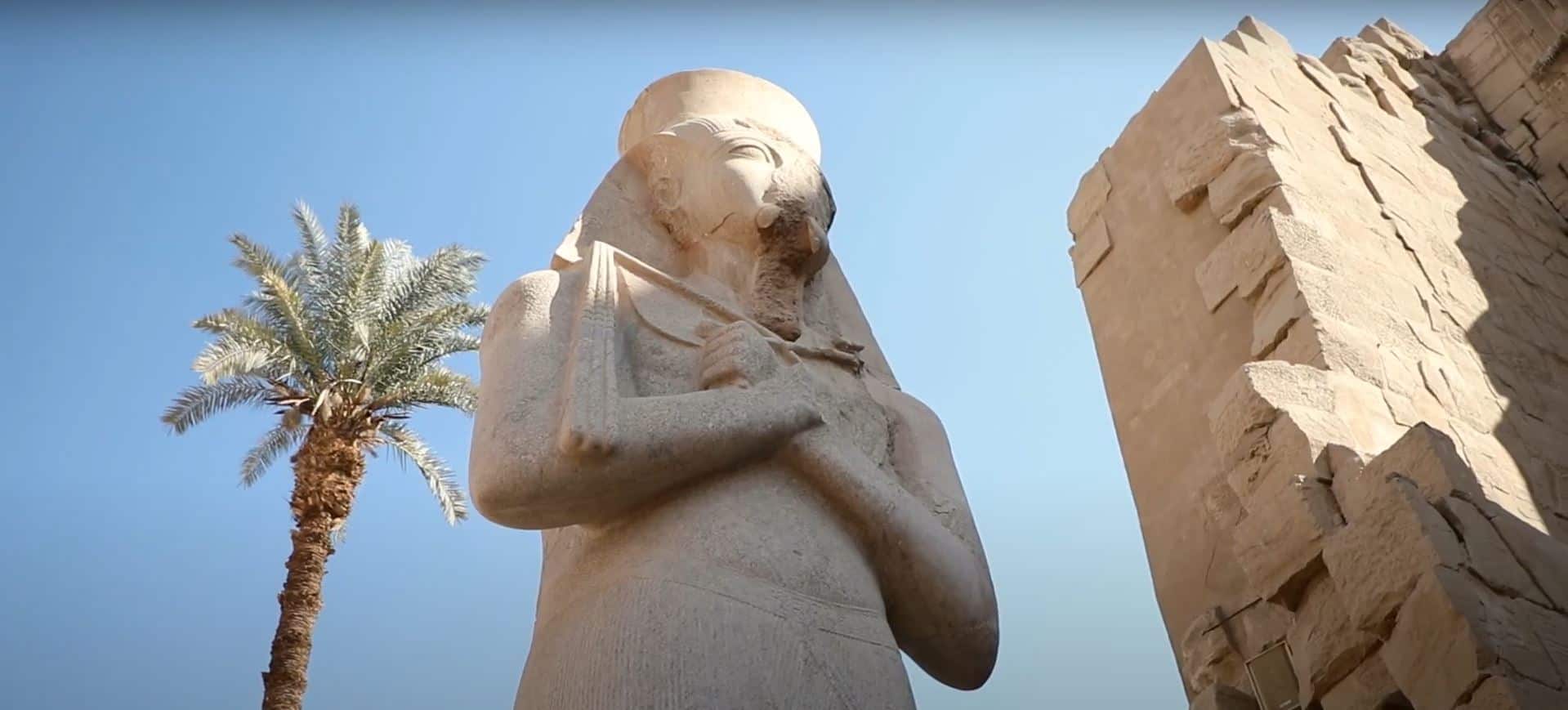El Karnak Temple – Luxor – Egypt

Updated On: February 22, 2024 by Ahmed Samir
In the heart of Luxor, Egypt, where the timeless waters of the Nile River gently flow, stands a marvel of ancient architecture and spiritual significance – El Karnak Temple. Its colossal stone pillars, intricate carvings, and wealthy historical tapestry beckon travellers and history enthusiasts alike to embark on a journey through the annals of human civilization. El Karnak Temple, also known as Karnak Temple Complex, is a testament to the ancient Egyptians’ grandeur, devotion, and ingenuity.
In this comprehensive exploration, we will embark on a virtual expedition to unravel the mysteries and unveil the wonders of this sacred sanctuary, delving deep into its history, architectural splendours, and cultural significance. Join us on this voyage back in time as we navigate the enchanting realms of El Karnak Temple and unlock the secrets of a bygone era.
Chronicles of El Karnak Temple: A Journey Through Time
El Karnak Temple, also known as Karnak Temple Complex, holds a special place in the annals of Egyptian history. Its construction spanned over a thousand years, making it one of the longest-running construction projects in the ancient world. The temple complex was dedicated to the Theban Triad, which consisted of the god Amun, his consort Mut, and their son Khonsu.
The earliest origins of El Karnak Temple can be traced back to the Middle Kingdom period (c. 2055–1650 BCE). However, the most significant expansions and additions to the temple complex occurred during the New Kingdom period (c. 1550–1070 BCE), when Egypt was at the height of its power and prosperity. During this period, the pharaohs were determined to demonstrate their devotion to the gods and establish their legacy through monumental architecture.
The reign of Amenhotep III (1391–1353 BCE) marked a golden age for the temple complex. Amenhotep III was responsible for constructing the most famous part of the temple, the Great Hypostyle Hall. This hall consists of 134 massive columns arranged in a grid pattern, creating a mesmerizing stone forest. The columns are adorned with intricate hieroglyphics and carvings that tell stories of the pharaoh’s reign and the divine rituals conducted within the temple.
Another significant ruler in the history of El Karnak Temple was Ramesses II (1279–1213 BCE), one of Egypt’s most renowned pharaohs. Ramesses II added his grand contributions to the temple complex, including the famous obelisks and the imposing Court of Ramesses II. His reign, which lasted for over six decades, witnessed extensive building projects and military campaigns, further solidifying Egypt’s dominance in the ancient world.
The Structure and Design of El Karnak Temple
The architecture of El Karnak Temple is a stunning example of ancient Egyptian ingenuity and craftsmanship. The temple complex covers an area of approximately 200 acres, making it the most significant religious site ever built. Its layout is characterized by enclosed precincts dedicated to a specific deity.
- The Precinct of Amun-Re: At the heart of El Karnak Temple lies the Precinct of Amun-Re, the most sacred area of the complex. This precinct was dedicated to the god Amun, the king of the Egyptian pantheon. The precinct is entered through a massive pylon, or gateway, adorned with colossal statues and intricate relief carvings. Beyond the pylon, visitors encounter the expansive Great Court, which leads to the awe-inspiring Great Hypostyle Hall.
- The Great Hypostyle Hall: The Great Hypostyle Hall is a true architectural marvel. It measures 54,000 square feet and features 134 massive columns, each standing over 70 feet tall. These columns, arranged in 16 rows, create a forest-like atmosphere within the hall. The sheer size and scale of the columns, coupled with the elaborate decorations, are a testament to the power and ambition of the pharaohs who built them. The hall served as a place for religious rituals and gatherings, where priests and devotees would commune with the gods.
- The Avenue of Sphinxes: Connecting the Precinct of Amun-Re with the Precinct of Mut is the Avenue of Sphinxes, a long and majestic pathway flanked by rows of sphinx statues. These statues have a lion’s body and a ram’s head, symbolizing the god Amun-Re. The avenue was once lined with hundreds of these sphinxes, creating an impressive approach to the temple.
- The Precinct of Mut: Dedicated to the goddess Mut, the Precinct of Mut is another significant part of El Karnak Temple. It features a beautiful temple adorned with statues and reliefs. Mut was considered a mother goddess and the consort of Amun-Re, emphasizing the importance of family in Egyptian mythology.
- The Precinct of Montu: This smaller precinct is dedicated to the warrior god Montu and includes a temple and various structures. Montu was associated with strength and victory in battle, making this precinct a place of worship for warriors and soldiers.
- The Precinct of Ptah: Ptah, the god of craftsmen and creation, is honoured in this precinct. Although smaller than the other precincts, it holds great significance for its role in ancient Egypt’s religious and cultural life.
The reign of Amenhotep III (1391–1353 BCE) marked a golden age for the temple complex. Amenhotep III was responsible for constructing the most famous part of the temple, the Great Hypostyle Hall. This hall consists of 134 massive columns arranged in a grid pattern, creating a mesmerizing stone forest. The columns are adorned with intricate hieroglyphics and carvings that tell stories of the pharaoh’s reign and the divine rituals conducted within the temple.
Another significant ruler in the history of El Karnak Temple was Ramesses II (1279–1213 BCE), one of Egypt’s most renowned pharaohs. Ramesses II added his grand contributions to the temple complex, including the famous obelisks and the imposing Court of Ramesses II. His reign, which lasted for over six decades, witnessed extensive building projects and military campaigns, further solidifying Egypt’s dominance in the ancient world.
El Karnak Temple’s Role in Ancient Egypt
El Karnak Temple played a central role in ancient Egypt’s religious and political life. It was a place of worship and a symbol of the pharaoh’s divine authority and the nation’s prosperity. The temple complex served multiple functions:
- Worship: Priests and devotees would gather in the temple to perform various rituals and ceremonies dedicated to the gods. These rituals included offerings, prayers, and processions. The temple was believed to be the dwelling place of the gods on Earth.
- Pilgrimage: El Karnak Temple attracted pilgrims from all over Egypt and beyond. People would journey to the temple to seek the blessings of the gods, make offerings, and partake in religious festivals.
- Administrative Center: The temple complex also had administrative functions. It served as a hub for managing the vast wealth and resources of the temple, including lands, livestock, and offerings from devotees. Priests played a crucial role in overseeing these affairs.
- Symbol of Power: The construction and expansion of El Karnak Temple were often used as political statements by pharaohs to assert their authority and divine legitimacy. The greater the temple’s grandeur, the more powerful and favoured the pharaoh was believed to be by the gods.
- Religious Festivals: The temple complex hosted numerous religious festivals throughout the year, attracting large crowds of worshipers and visitors. These festivals included processions, music, dance, and other forms of entertainment.
Guardians of the Past: Iconic Elements and Statues at El Karnak Temple
El Karnak Temple is renowned for its remarkable features and statues, each with historical and artistic significance. Some of the most notable include:
- Obelisks: The temple complex is adorned with several obelisks, including the famous obelisks of Hatshepsut and Thutmose III. These towering, slender monuments were carved from single blocks of red granite and were often inscribed with hieroglyphics detailing the accomplishments of the pharaohs.
- Colossal Statues: Gigantic statues of pharaohs and gods are scattered throughout the complex, serving as reminders of the grandeur of ancient Egypt. The Colossi of Memnon, two massive figures of Amenhotep III, are particularly famous and have stood for millennia.
- Sekhmet Statues: El Karnak Temple features numerous statues of the lion-headed goddess Sekhmet, a fierce and protective deity. These statues were believed to have the power to heal and protect and played a role in ancient Egyptian medicine.
- Scarab Beetle: One of the fascinating artefacts within the temple is the Sacred Scarab, a massive scarab beetle statue made of black granite. Scarabs were associated with regeneration and the sun god Ra.
- The White Chapel: This small but intricately decorated chapel was built by Senusret I during the Middle Kingdom period. It features delicate white Tura limestone with exquisite reliefs and inscriptions.
Conservation Efforts and Tourism
El Karnak Temple has survived for millennia but has not been without its challenges. Over the centuries, the temple complex faced natural disasters, erosion, and even human intervention. However, dedicated efforts have been made to preserve and protect this remarkable archaeological site.
In recent years, UNESCO and the Egyptian government have collaborated on extensive restoration projects to safeguard the temple complex. These efforts have included cleaning, conserving, and restoring various parts of the temple, ensuring that future generations can continue to marvel at its beauty and historical significance.
El Karnak Temple is one of Egypt’s most popular tourist attractions today. Visitors worldwide come to Luxor to explore its vast courtyards, towering columns, and rich history. The temple complex offers a glimpse into ancient Egypt’s religious and cultural life, allowing modern-day travellers to connect with the past.
Conclusion
El Karnak Temple in Luxor, Egypt, is an enduring testament to ancient Egypt’s grandeur, spirituality, and architectural prowess. With its colossal columns, intricate hieroglyphics, and deep historical significance, it continues to captivate and inspire visitors from around the globe. As we marvel at the achievements of the pharaohs and the dedication of the priests who served here, we are reminded of the enduring legacy of one of the world’s most magnificent archaeological wonders. El Karnak Temple is a window into the past and a symbol of human ingenuity and devotion to the divine that transcends the ages.
FAQs
Is El Karnak Temple open to tourists?
El Karnak Temple is a popular tourist destination in Luxor, Egypt. Visitors worldwide can explore its vast courtyards, towering columns, and rich history.
How has El Karnak Temple been preserved over the years?
El Karnak Temple has undergone extensive restoration and conservation efforts, often in collaboration with UNESCO and the Egyptian government, to safeguard its historical and architectural treasures.
Are there guided tours available for visitors who want to learn more about the temple’s history and significance?
Yes, guided tours by experienced Egyptologists and tour guides are available for visitors who want a deeper understanding of El Karnak Temple’s history, architecture, and cultural significance.






